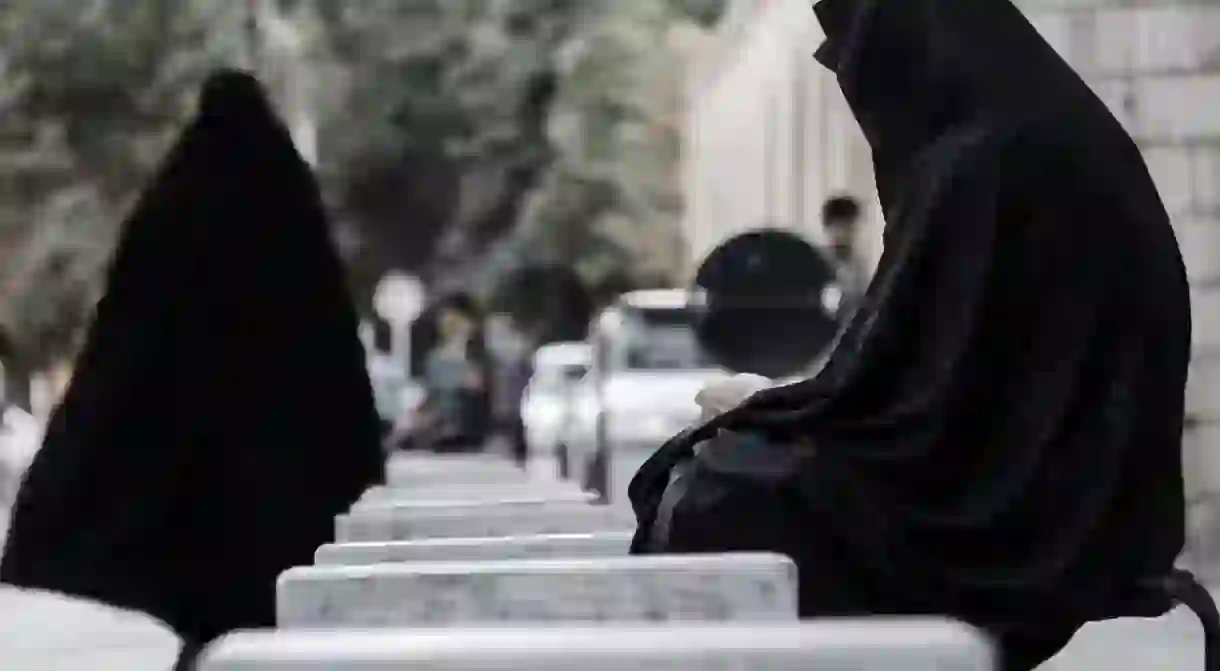Iranian Men Are Wearing Hijab And Here's Why

In Iran, the lives of of women are shrouded both figuratively and literally. The pursuit of education and self-expression are dangerous freedoms to covet in a country where 72 lashes are the punishment for failing to comply with mandatory hijab laws. For many, the traditional Muslim veil can be just as much a symbol of a woman’s oppression as it is a symbol of privacy, modesty and morality. The idea that a woman needs to be concealed is one that ruffles the feathers of many; especially in Iran where men are turning to social media to don their own hijab, defend women’s rights and defy their own government.
A photo posted by Reserva (@usereserva) on Aug 5, 2016 at 11:45am PDT
Since the 1979 Islamic Revolution, the wearing of hijab has become a mandatory custom for women in Iran. For Iranian women, as well as visiting foreigners, wearing hijab is enforced in all facets of life – from the airport (where female tourists can be denied entry into Iran for failing to wear it) to the streets (where women face fines and punishment). Masih Alinejad is an Iranian activist and journalist whose ‘My Stealthy Freedom‘ campaign has given birth to the highly controversial #MeninHijab movement, in which women challenge their husbands, brothers and fathers to wear the traditional cover.
A photo posted by Masih Alinejad (@masih.alinejad) on Aug 22, 2016 at 8:27am PDT
‘My Stealthy Freedom’ began when Masih shared a photo of herself – without hijab – jogging in London. In the caption, Masih described the wind in her hair and how it reminded her of the oppression facing her – and countless other women – back in Iran. Her photo captured the attention of many who were inspired to share their own moments of ‘stealthy freedom’ without hijab.
The first #MeninHijab photo appeared when Masih – ever the renegade – photoshopped Iranian Foreign Minister, Javad Zarif, in hijab. The photo came in response to Zarif being challenged on the issue of mandatory hijab laws, particularly as they pertain to visiting tourists. His dismissive response on the issue inspired Masih to post the controversial image with the caption: “Mr. Zarif, let me say that I have a great deal of respect for your diplomatic skills; but take a look at this photo of yourself wearing the hijab. How do you feel? The picture is comical? Weird? Or do you see it as a personal insult? That’s exactly how the women who do not believe in [mandatory] hijab feel.”
A photo posted by Masih Alinejad (@masih.alinejad) on Aug 20, 2016 at 12:48am PDT
The photo sparked a movement as Iranian women challenged the men in their lives to wear hijab. The photos began pouring into social media under the unifying hashtag, #MeninHijab, in protest of the oppressive, gender discriminatory laws in Iran. In response to both her ‘My Stealthy Freedom’ movement and #MeninHijab campaign, Masih received relentless backlash from the Iranian government. “Iranian State television – on the news channel – said I was raped by three men in London,” said Masih, “It was a big lie but they [Iranian officials] wanted to discredit me. In their minds they think if a woman is raped it’s her fault and they [fabricated the story] to stop women from supporting me.”
A photo posted by Masih Alinejad (@masih.alinejad) on Jul 30, 2016 at 11:23am PDT
For the men who took part in the #MeninHijab movement, Iranian websites branded them “dishonorable” – an unmentionable insult in the Islamic world. Despite the venomous response from officials, Masih and her supporters march on because the issue of hijab is an issue affecting men and women. “It’s not just a piece of cloth,” proclaims Masih, “it’s about your dignity.” Masih explains how hijab does more than deprive women of choice; it insults men with the assumption that they can’t control themselves in the presence of an uncovered woman. “The #MeninHijab movement is important because we want to make clear that Iranian men are not like what the Iranian government [portrays them to be]. Through [the #MeninHijab] platform, you can hear the true voice of Iranian men.” That voice – as Masih tells Culture Trip – is one of understanding, support and desire to usher in a new era of gender equality.
A photo posted by Masih Alinejad (@masih.alinejad) on Aug 1, 2016 at 3:44am PDT
In the end, Masih hopes to create dialogue and spark conversation about hijab. “I want to [create] awareness in the world and tell [the Iranian government] that [mandatory hijab] cannot be part of a country’s culture,” explains Masih. Many may not understand the emotional implications of wearing hijab, to which Masih describes the tradition as a form of humiliation: “It’s an insult. From the age of seven, they take your identity away from you so that you have to be someone else, you have to have a double life.”
While most of the #MeninHijab activists are of a younger generation, Masih explains that older generations are joining the cause too – a fact that makes the movement that much more empowering. She describes a friend whose elderly father – after spotting Masih in a televised interview – wondered what the “big deal” was about wearing hijab. In response, his daughter challenged him to wear the veil for an hour. At first the father scoffed – laughing the hijab was a disaster on him – but after an hour, he came to his daughter in awe of how she could stand it for 30 years. It’s this understanding that Masih hopes to foster as men (finally) see what it’s like to walk a mile in a woman’s hijab.













